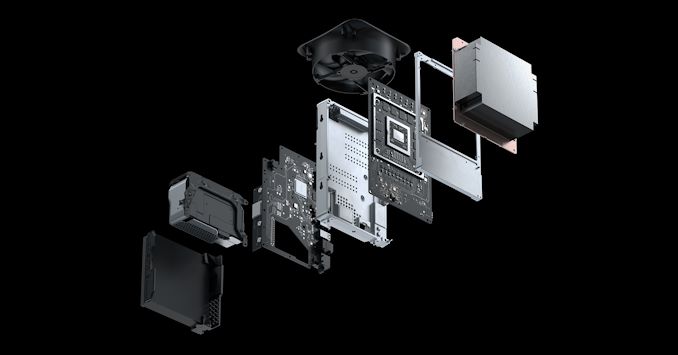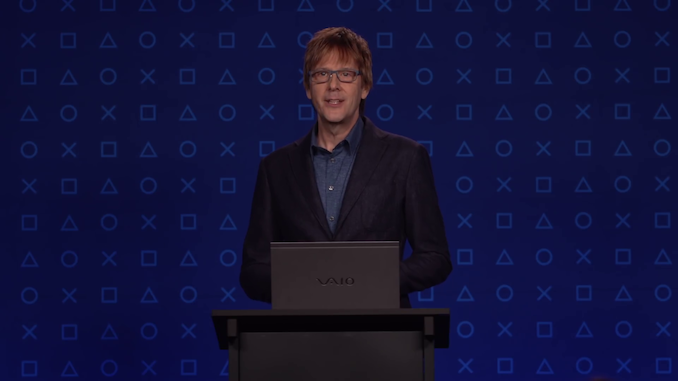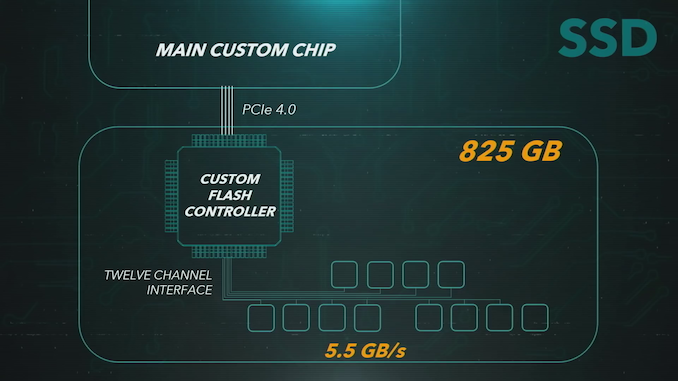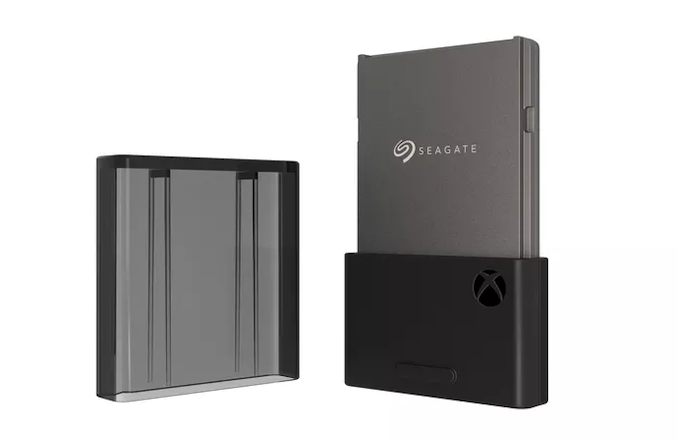Storage Matters: Why Xbox and Playstation SSDs Usher In A New Era of Gaming
by Billy Tallis on June 12, 2020 9:30 AM EST- Posted in
- SSDs
- Storage
- Microsoft
- Sony
- Consoles
- NVMe
- Xbox Series X
- PlayStation 5

A new generation of gaming consoles is due to hit the market later this year, and the hype cycle for the Xbox Series X and Playstation 5 has been underway for more than a year. Solid technical details (as opposed to mere rumors) have been slower to arrive, and we still know much less about the consoles than we typically know about PC platforms and components during the post-announcement, pre-availability phase. We have some top-line performance numbers and general architectural information from Microsoft and Sony, but not quite a full spec sheet.
The new generation of consoles will bring big increases in CPU and GPU capabilities, but we get that with every new generation and it's no surprise when console chips get the same microarchitecture updates as the AMD CPUs and GPUs they're derived from. What's more special with this generation is the change to storage: the consoles are following in the footsteps of the PC market by switching from mechanical hard drives to solid state storage, but also going a step beyond the PC market to get the most benefit out of solid state storage.
Solid State Drives were revolutionary for the PC market, providing immense improvements to overall system responsiveness. Games benefited mostly in the form of faster installation and level load times, but fast storage also helped reduce stalls and stuttering when a game needs to load data on the fly. In recent years, NVMe SSDs have provided speeds that are on paper several times faster than what is possible with SATA SSDs, but for gamers the benefits have been muted at best. Conventional wisdom holds that there are two main causes to suspect for this disappointment: First, almost all games and game engines are still designed to be playable off hard drives because current consoles and many low-end PCs lack SSDs. Game programmers cannot take full advantage of NVMe SSD performance without making their games unplayably slow on hard drives. Second, SATA SSDs are already fast enough to shift the bottleneck elsewhere in the system, often in the form of data decompression. Something aside from the SSD needs to be sped up before games can properly benefit from NVMe performance.
Microsoft and Sony are addressing both of those issues with their upcoming consoles. Game developers will soon be free to assume that users will have fast storage, both on consoles and on PCs. In addition, the new generation of consoles will add extra hardware features to address bottlenecks that would be present if they were merely mid-range gaming PCs equipped with cutting-edge SSDs. However, we're still dealing with powerful hype operations promoting these upcoming devices. Both companies are guilty of exaggerating or oversimplifying in their attempts to extol the new capabilities of their next consoles, especially with regards to the new SSDs. And since these consoles are still closed platforms that aren't even on the market yet, some of the most interesting technical details are still being kept secret.
The main source of official technical information about the PS5 (and especially its SSD) is lead designer Mark Cerny. In March, he gave an hour-long technical presentation about the PS5 and spent over a third of it focusing on storage. Less officially, Sony has filed several patents that apparently pertain to the PS5, including one that lines up well with what's been confirmed about the PS5's storage technology. That patent discloses numerous ideas Sony explored in the development of the PS5, and many of them are likely implemented in the final design.
Microsoft has taken the approach of more or less dribbling out technical details through sporadic blog posts and interviews, especially with DigitalFoundry (who also have good coverage of the PS5). They've introduced brand names for many of their storage-related technologies (eg. "Xbox Velocity Architecture"), but in too many cases we don't really know anything about a feature other than its name.
Aside from official sources, we also have leaks, comments and rumors of varying quality, from partners and other industry sources. These have definitely helped fuel the hype, but with regards to the console SSDs in particular, these non-official sources have produced very little in the way of real technical details. That leaves us with a lot of gaps that require analysis of what's possible and probable for the upcoming consoles to include.
What do we know about the console SSDs?
Microsoft and Sony are each using custom NVMe SSDs for their consoles, albeit with different definitions of "custom". Sony's solution aims for more than twice the performance of Microsoft's solution and is definitely more costly even though it will have the lower capacity. Broadly speaking, Sony's SSD will offer similar performance to the high-end PCIe 4.0 NVMe SSDs we expect to see on the retail market by the end of the year, while Microsoft's SSD is more comparable to entry-level NVMe drives. Both are a huge step forward from mechanical hard drives or even SATA SSDs.
| Console SSD Confirmed Specifications | |||
| Microsoft Xbox Series X |
Sony Playstation 5 |
||
| Capacity | 1 TB | 825 GB | |
| Speed (Sequential Read) | 2.4 GB/s | 5.5 GB/s | |
| Host Interface | NVMe | PCIe 4.0 x4 NVMe | |
| NAND Channels | 12 | ||
| Power | 3.8 W | ||
The most important and impressive performance metric for the console SSDs is their sequential read speed. SSD write speed is almost completely irrelevant to video game performance, and even when games perform random reads it will usually be for larger chunks of data than the 4kB blocks that SSD random IO performance ratings are normally based upon. Microsoft's 2.4GB/s read speed is 10–20 times faster than what a mechanical hard drive can deliver, but falls well short of the current standards for high-end consumer SSDs which can saturate a PCIe 3.0 x4 interface with at least 3.5GB/s read speeds. Sony's 5.5GB/s read speed is slightly faster than currently-available PCIe 4.0 SSDs based on the Phison E16 controller, but everyone competing in the high-end consumer SSD market has more advanced solutions on the way. By the time it ships, the PS5 SSD's read performance will be unremarkable – matched by other high-end SSDs – except in the context of consoles and low-cost gaming PCs that usually don't have room in the budget for high-end storage.
Sony has disclosed that their SSD uses a custom controller with a 12-channel interface to the NAND flash memory. This seems to be the most important way in which their design differs from typical consumer SSDs. High-end consumer SSDs generally use 8-channel controllers and low-end drives often use 4 channels. Higher channel counts are more common for server SSDs, especially those that need to support extreme capacities; 16-channel controllers are common and 12 or 18 channel designs are not unheard of. Sony's use of a higher channel count than any recent consumer SSD means their SSD controller will be uncommonly large and expensive, but on the other hand they don't need as much performance from each channel in order to reach their 5.5GB/s goal. They could use any 64-layer or newer TLC NAND and have adequate performance, while consumer SSDs hoping to offer this level of performance or more with 8-channel controllers need to be paired with newer, faster NAND flash.
The 12-channel controller also leads to unusual total capacities. A console SSD doesn't need any more overprovisioning than typical consumer SSDs, so 50% more channels should translate to about 50% more usable capacity. The PS5 will ship with "825 GB" of SSD space, which means we should see each of the 12 channels equipped with 64GiB of raw NAND, organized as either one 512Gbit (64GB) die or two 256Gbit (32GB) dies per channel. That means the nominal raw capacity of the NAND is 768GiB or about 824.6 (decimal) GB. The usable capacity after accounting for the requisite spare area reserved by the drive is probably going to be more in line with what would be branded as 750 GB by a drive manufacturer, so Sony's 825GB is overstating things by about 10% more than normal for the storage industry. It's something that may make a few lawyers salivate.
It's probably worth mentioning here that it is unrealistic for Sony to have designed their own high-performance NVMe SSD controller, just like they can't do a CPU or GPU design on their own. Sony had to partner with an existing SSD controller vendor and commission a custom controller, probably assembled largely from pre-existing and proven IP, but we don't know who that partner is.
Microsoft's SSD won't be pushing performance at all beyond normal new PC levels now that OEMs have moved beyond SATA SSDs, but a full 1TB in a PC priced similarly to consoles would still be a big win for consumers. Multiple sources indicate that Microsoft is using an off-the-shelf SSD controller from one of the usual suspects (probably the Phison E19T controller), and the drive itself is built by a major SSD OEM. However, they can still lay claim to using a custom form factor and probably custom firmware.
Neither console vendor has shared official information about the internals of their SSD aside from Sony's 12-channel specification, but the capacities and performance numbers give us a clue about what to expect. Sony's pretty much committed to using TLC NAND, but Microsoft's lower performance target is down in the territory where QLC NAND is an option: 2.4GB/s is a bit more than we see from current 4-channel QLC drives like the Intel 665p (about 2GB/s) but much less than 8-channel QLC drives like the Sabrent Rocket Q (rated 3.2GB/s for the 1TB model). The best fit for Microsoft's expected performance among current SSD designs would be a 4-channel drive with TLC NAND, but newer 4-channel controllers like the Phison E19T should be able to hit those speeds with the right QLC NAND. Either console could conceivably in the future get a double-capacity version that uses QLC NAND to reach the same read performance of the original models.
DRAMless, but that's OK?
Without performance specs for writes or random reads, we cannot rule out the possibility of either console SSD using a DRAMless controller. Including a full-sized DRAM cache for the flash translation layer (FTL) tables on a SSD primarily helps performance in two ways: better sustained write speeds when the drive's full enough to require a lot of background work shuffling data around, and better random access speed when reading data across the full range of the drive. Neither of those really fits the console use case: very heavily read-oriented, and only accessing one game's dataset at a time. Even if game install sizes end up being in the 100-200GB range, at any given moment the amount of data used by a game won't be more than low tens of GB, and that is easily handled by DRAMless SSDs with a decent amount of SRAM on the controller itself. Going DRAMless seems very likely for Microsoft's SSD, and while it would be very strange in any other context to see a 12-channel DRAMless controller, that option does seem to be viable for Sony (and would offset the cost of the high channel count).
The Sony patent mentioned earlier goes in depth on how to make a DRAMless controller even more suitable for console use cases. Rather than caching a portion of the FTL's logical-to-physical address mapping table in on-controller SRAM, Sony proposes making the table itself small enough to fit in a small SRAM buffer. Mainstream SSDs have a ratio of 1 GB of DRAM for each 1 TB of flash memory. That ratio is a direct consequence of the FTL managing flash in 4kB chunks. Having the FTL manage flash in larger chunks directly reduces the memory requirements for the mapping table. The downside is that small writes will cause much more write amplification and be much slower. Western Digital sells a specialized enterprise SSD that uses 32kB chunks for its FTL rather than 4kB, and as a result it only needs an eighth the amount of DRAM. That drive's random write performance is poor, but the read performance is still competitive. Sony's patent proposes going way beyond 32kB chunks to using 128MB chunks for the FTL, shrinking the mapping table to mere kilobytes. That requires the host system to be very careful about when and where it writes data, but the read performance that gaming relies upon is not compromised.
In short, while the Sony SSD should be very fast for its intended purpose, I'm going to wager that you really wouldn't want it in your Windows PC. The same is probably true to some extent of Microsoft's SSD, depending on their firmware tuning decisions.
Expandability
Both Microsoft and Sony are providing expandability for the NVMe storage of their upcoming consoles. Microsoft's solution is to re-package their internal SSD into a custom removable form factor reminiscent of what consoles used back when memory cards were measured in MB instead of TB and before USB flash drives were ubiquitous. Since it uses all the same components, this expansion card will be functionally identical to the internal storage. The downside is that Microsoft will control the supply and probably pricing of the cards; currently Seagate is the only confirmed partner for selling these proprietary expansion cards.
Sony is taking the opposite approach, by giving users access to a standard M.2 PCIe 4.0 slot that can accept aftermarket upgrades. The requirements aren't entirely clear: Sony will be doing compatibility testing with third-party drives in order to publish a compatibility list, but they haven't said whether drives not on their approved list will be rejected by the PS5 console. To make it onto Sony's compatibility list, a drive will need to mechanically fit (ie. no excessively large heatsink) and offer at least as much performance as Sony's custom internal SSD. The performance requirements mean no drive currently available at retail will qualify, but the situation will be very different next year.














200 Comments
View All Comments
ikjadoon - Friday, June 12, 2020 - link
*even have....jeremyshaw - Friday, June 12, 2020 - link
Are there even laptops with a PCIe 4.0 M.2 slot at all? Intel doesn't. AMD doesn't. None of the arm vendors have PCIe 4.0 on their laptop SoCs.lmcd - Friday, June 12, 2020 - link
AMD explicitly didn't include PCIe 4.0 on their latest laptop line, I forgot about that until you mentioned it.lightningz71 - Friday, June 12, 2020 - link
About the closest that you can get are a handful of the mega laptops that use desktop processors with a pair of NVME slots, or some of the newest gaming laptops that feature the Ryzen 4000 processors that have a pair of M.2 PCIe slots that are direct attached to the CPU.The closest that you're going to get right now is a 4800H, a pair of high end M.2 NVME drives, 32 GB of RAM, and an rtx 2060. That's hardly going to meet console specs.
Kangal - Sunday, June 14, 2020 - link
Well, the Ryzen-4000 platform shares alot in common with the APUs inside both the PS5 and the Xbox SeX.The difference is that laptops have a much larger power and thermal constraints, and much less GPU requirements. Also where consoles are meant to be a baseline for 5-10 Years, there's really no such thing for laptops as they can be obsoleted very quickly (remember the late 90s - early 00s?).
I also think both Microsoft and Sony engineers helped AMD in collaboration, which would've also benefited their development of Ryzen-4000 platform. With the only stipulation that AMD doesn't make and sell similar APUs on the market. Hence why Ryzen-4000 uses the obsolete Vega iGPU and that the Radeon Division has yet to release any RDNA2 dGPU to the market. They're waiting for the consoles to release first, well, it is AMDs cash cow anyway. Gaming PCs will soon dwarf the consoles again, but not until 2022. Just like how the 2005 Xbox 360 was competitive with PCs back then, or in 2002 with the Xbox, or in 2000 with the PS2... or back even further to 1996 with the N64. Consoles can be competitive, but they never make a lead and hold on to it.
Tams80 - Friday, June 12, 2020 - link
And they can slap "for PS5" on them charge a tidy premium that people will lap up (and likely complain about, but they'll do it).Sertain - Friday, June 12, 2020 - link
Just FYI, it's priority levels/que levels, not lanes that NVMe and the new Sony NVMe drive have.And I believe it is quite possible that the main difference between the Sony Drive 5.5GB/s and the Microsoft 2.4GB/s has more to do with PCIe lane provisioning...
Sony has been clear that they have 'a' m.2 bay, while Microsoft has also been clear that they have two slots (internal and external)
Per the specs, Sony definitely is using a PCIe Gen4 with x4 lanes for their M.2 and drawings from Microsoft would indicate that they broke that up into two separate x2 lanes chunks, one to internal and one to external. The AMD parts likely only has a certain number of PCIe lanes and i would be very surprised if Microsoft had a total of 8 extra PCIe Gen4 lanes vs Sony's x4. The logical conclusion is that the reason Microsoft's numbers are lower is due to half the lanes. I guess we will find out.
leexgx - Sunday, June 14, 2020 - link
i think sony is maybe taking it just to complex to be really beneficial, i understand if this was a cheap Sata SSD but a NVME ssd have so high IO output seems unnecessary fuss (should've just gone with a Gen4 NVME ssd with a cooled pad maybe to prevent thermal throttling)Jorgp2 - Friday, June 12, 2020 - link
Xbox SSD is most likely QLC with lots of spare area.Billy Tallis - Friday, June 12, 2020 - link
There's no reason for these SSDs to have a lot of spare area.